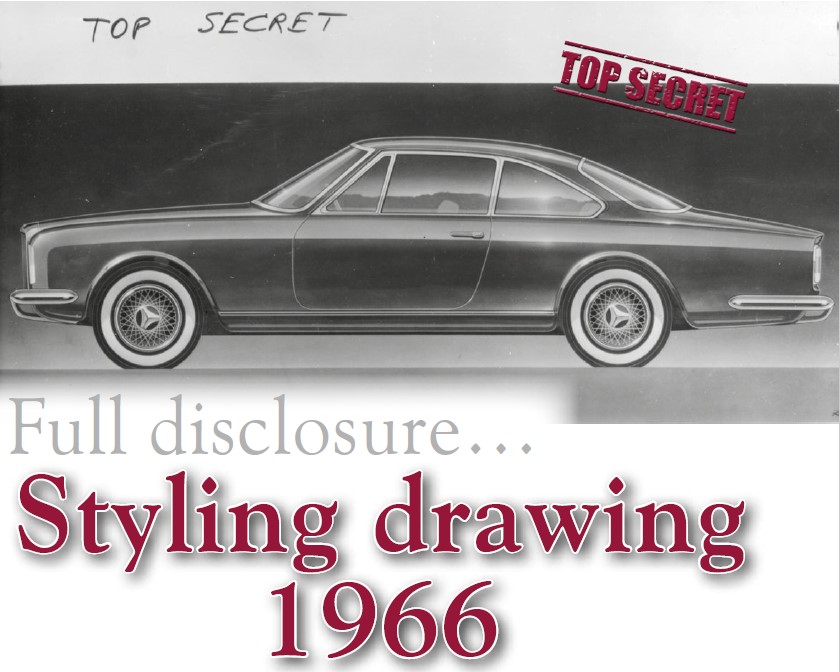
NJH Smith relates another compelling tale of one of these mysterious might-havebeens – a Camargue perhaps or something else? Images: Courtesy of WOBMF archives and Lord Bamford
Let’s start with a brief recap. The Camargue wasn’t a Bentley, the car in our main drawing (above) looks like a Ferrari, the style of the rendering bears no resemblance to the output of Crewe’s Styling Office and, for good measure, an anonymous graffiti artist has hastily scrawled TOP SECRET above the beautifully finished presentation rendering before it was photographed. The confusions multiply… In fact, the car imagined in this design is only indirectly connected to the Camargue, although the origins of both lie in the same renowned Turin design studio which from the 1930s to the 1980s was a hotbed of creativity, responsible for an unparalleled sequence of influential motoring masterpieces.
Our image depicts the unexecuted original proposal for the spectacular and unique Bentley T Type, designed and built by Pininfarina to the commission of James Hanson, one of the most successful and high profile British businessmen of the 1960s. But why does the completed Bentley differ so obviously from the rendering? The answer is that our mystery drawing records a hitherto overlooked and unknown first stage proposal by Pininfarina. With the help of detailed research by Bernard King, we can now assemble the pieces of the jigsaw and explain how this rendering slots into the convoluted birth of Hanson’s Coupe Speciale.
Summer 1965
By mid-1965, with the announcement of the revolutionary T Type imminent, James Hanson (later Sir James and finally Baron Hanson) had become the archetype of the buccaneering entrepreneur, equally renowned for his corporate derring-do by day and his exploits in the night clubs of the world after hours. While transforming his small family transport business into a major contract haulage company and simultaneously building up a second haulage business in Canada, in his native Yorkshire he had also co-founded Jet Petroleum, Britain’s first cut-price petrol retailer. The sale of Jet in 1961 and the Canadian operation in 1963 injected a tidal wave of cash into the Hanson coffers.

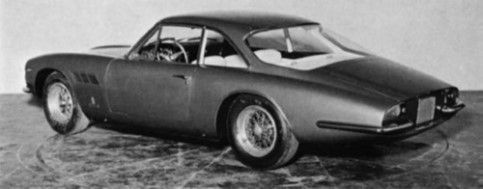
A clear resemblance can be seen between the Ferrari 500 Superfast and Pininfarina’s first proposal for James Hanson’s Bentley
Still hot in pursuit of new business worlds to conquer, he also took the opportunity to indulge himself – and one of his passions was fast cars. Fortunately for our story, among these was one of the 36 Ferrari 500 Superfasts, launched in 1964 with 400bhp, a top speed of 175mph, a price of £11,500 (the cost of two Bentley S3 saloons) and coachwork designed by… Pininfarina.
The view from Turin
Established in 1930 by Battista ‘Pinin’ Farina, the eponymous coachbuilder rose quickly to fame over the following decade, combining a series of extravagant concours winners with short runs of more restrained but beautifully proportioned saloons and coupes on Alfa Romeo, Fiat and Lancia chassis.
This run of success continued post-war. One highlight was the seminal Cisitalia 202 coupe of 1947, while the company also designed a small number of Bentleys. Gradually, however, Pinin Farina’s business was evolving as the company established a close relationship with Ferrari and began to act in the role of consultant designer for manufacturers such as BMC and Peugeot. Under the leadership of Battista’s son Sergio and son-in-law Renzo Carli, the opening in 1961 of a much
expanded new factory at Grugliasco in the suburbs of Turin allowed the newly renamed Pininfarina to launch into sub-contract bodywork manufacturing. Thus by the mid- 1960s Pininfarina had refashioned itself from a master coachbuilder to an architect of cars, to borrow Michael Frostick’s apt summary. Year by year its output of bespoke coachbuilt solitaires dwindled to almost zero, to be replaced by a series of eye-catching show cars intended as calling cards to exhibit the company’s skills to the world’s automobile manufacturers.
James Hanson’s own original sketch for his Bentley
Meanwhile in London…
It was against this background that in the late summer of 1965 James Hanson approached HR Owen, the London Bentley dealer, and Sergio Pininfarina about commissioning a bespoke Bentley on the new T Type base unit and running gear. As Hanson later recalled, “He [Sergio Pininfarina] got quite excited about the idea and agreed to do it at cost price because he felt he would be able to persuade Rolls-Royce to use his prototype as the new Bentley Continental. I just said to them, ‘Do it as if you are doing a Ferrari – it’s your car, so put your signature on it.’” And that is the design which appears in the mystery image, its origin confirmed by the ‘R’ just visible in the lower right-hand corner, the signature of Adriano Rabbone, one of Pininfarina’s senior designers. Originally intended by Hanson as a Rolls-Royce (he owned no fewer than 16 Silver Shadows), the project quickly became a Bentley, with styling that incorporated design cues typical of Pininfarina’s output of the early to mid-1960s.
…and Crewe
Since our main image carries a reference number of Crewe’s photographic department, and since the project was indeed absolutely TOP SECRET, we can even venture a date: 23 March 1966, when Sergio Pininfarina and stylist Leonardo Fioravanti visited Crewe to discuss the project with John Blatchley, Chief Styling Engineer, and other senior engineers. On that day Pininfarina ambitiously announced that he intended the car to be a “showstopper” within six months at the 1966 London Motor Show. Yet the Coupe Speciale only made its public debut two years later – and the Bentley then exhibited was a completely new design. What caused the extraordinary delay to a car which Pininfarina had confidently intended to finalise, build and display within half a year?
A fresh start
After the visit to Crewe, the trail starts to go cold. We know that Hanson visited Pininfarina on 1 July 1966, but a hiatus follows. Did Pininfarina or his customer realise that the initial proposals were rapidly becoming obsolete as Pininfarina’s design language took new directions? Did the project need to be rethought? What is certain is that nine or more months of inaction passed by until in the first half of 1967 Paolo Martin, a recent recruit from Bertone, was assigned to start afresh. Hanson signed off Martin’s newly conceived design sketches, although insisting on the three-box concept of his original sketch rather than the short bobtail proposed by Martin. During summer 1967 a base unit with running gear and air conditioning system was shipped from Crewe and stripped down in Pininfarina’s workshop, where the skilled Torinese craftsmen created the new body directly without detailed construction drawings.
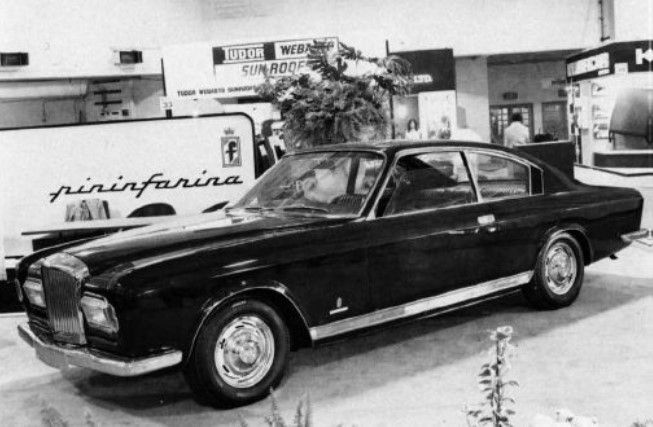
The T Type Pininfarina at Earls Court in 1968
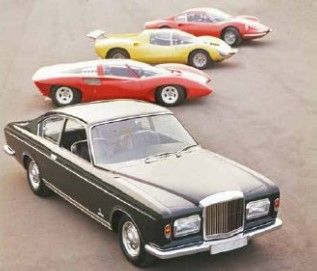
The Bentley stars with (front to rear) the Ferrari 250PS, Dino competition prototype and a production Dino at Pininfarina’s premises in 1968
By November 1967 the ‘body in white’ (finished in primer and without fittings) was ready for inspection by Blatchley, who was clearly impressed, as his report of the visit confirms.
The unveiling
Nonetheless, almost a further full year passed before the car eventually made its public debut at the Paris, London and Turin Motor Shows of October 1968, over three years since James Hanson first approached HR Owen. Given that he had consented to Pininfarina’s request to use the car for publicity, the timeline suggests it was probably completed earlier in 1968 and its announcement delayed to achieve maximum impact at the autumn shows. And the cost? An eye-watering £21,250 (well over £350,000 at 2021 prices), making it the world’s most expensive car in 1968, when the newly announced Phantom VI limousine was listed at a paltry £13,123.
Later years – and today
Eventually road registered (the car carried several registrations including Hanson’s personal number plate JEH 1), the Coupe Speciale remained in his motor house for almost 20 years. After its sale in 1987, it passed through owners in Japan, USA and UK until acquired by BDC Member Lord Bamford in 2015. Following a comprehensive restoration the car made its debut at the celebrated Villa d’Este concours in 2016 and was subsequently shown at Salon Privé in 2019.
The Bentley at Villa d’Este in 2016 after a full restoration, repaint and retrim
REFLECTIONS
How do we finally assess the Hanson T Type? A rich man’s extravagance? A shrewd (and indeed successful) strategy on the part of Sergio Pininfarina to gain access to the inner circles at Crewe? Or a glorious celebration of the golden years of Italian coachbuilding – the only truly bespoke design created for the T Type and effectively the swansong of Pininfarina’s private commissions. The Bentley Coupe Speciale is all of these, but anyone inspired by the elegance and style of Pininfarina’s creations and the quality of Crewe’s engineering will have no difficulty in deciding.
Thank you to the Bentley Drivers Club (BDC) for giving us kind permission to use this article on our website.
Become a member of the Bentley Driver Club today, visit www.bdcl.org/membership



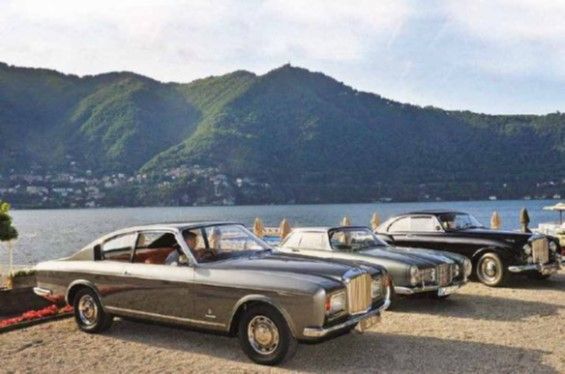
2 Oct 2023